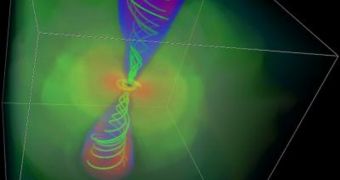Black holes are undoubtedly some of the most mysterious forms of matter in the entire known Universe. Studying them is tremendously difficult, primarily because they do not reflect back any type of radiation in the electromagnetic spectrum. Moreover, they also absorb light, as well as any other form of matter that is directed at them, which means that everything we send at them simply disappears. But computer models help us understand these behemoths better. At times however, they raise more questions than they answer, which is not what astrophysicists complain about.
Such was the case with a new investigation, which was conducted by physicists at the US Department of Energy's (DOE) SLAC National Accelerator Laboratory. The computer simulation revealed that gamma-rays, one of the main signatures of black holes, did not form as close to the event horizon as investigators first thought. This highly-energetic form of light appears to be created some distance away from the hole itself, which would further seem to indicate that the shape of the jets generating them is in fact a lot more complex that initially believed. Details of the investigation appear in the latest issue of the esteemed journal Nature.
The new work focused on the bright and very distant galaxies called blazars. Data on these structures were collected from about 20 high-precision telescopes, including the famous Fermi Gamma-ray Space Telescope. The information were decoded and organized by SLAC researchers, working closely with colleagues from the Stanford University. An international support team also assisted the investigators in their laborious job.
“As the Universe's biggest accelerators, blazar jets are important to understand. But how they are produced and how they are structured is not well understood. We're still looking to understand the basics,” says the corresponding author of the new paper Kavli Institute for Particle Astrophysics and Cosmology (KIPAC) research fellow Masaaki Hayashida. KIPAC astrophysicist Greg Madejski was also a corresponding author. “This work is a significant step toward understanding the physics of these jets. It's this type of observation that is going to make it possible for us to figure out their anatomy,” says the director of KIPAC, Roger Blandford.
“What we found was very different from what we were expecting. The data suggest that gamma rays are produced not one or two light days from the black hole [as was expected] but closer to one light year. That's surprising,” Madejski concludes.

 14 DAY TRIAL //
14 DAY TRIAL //